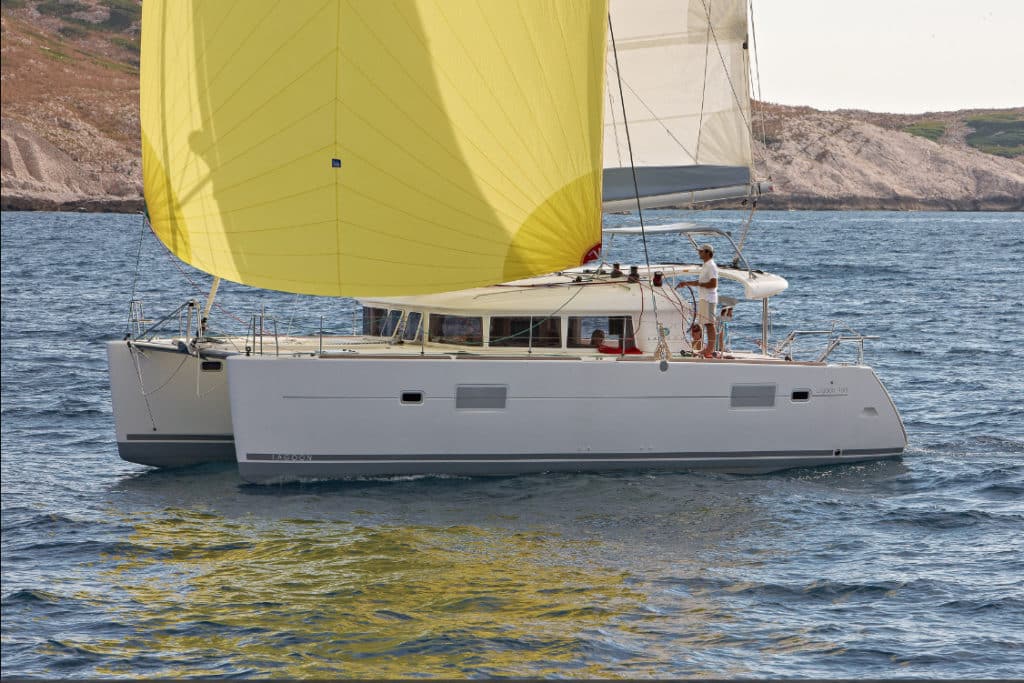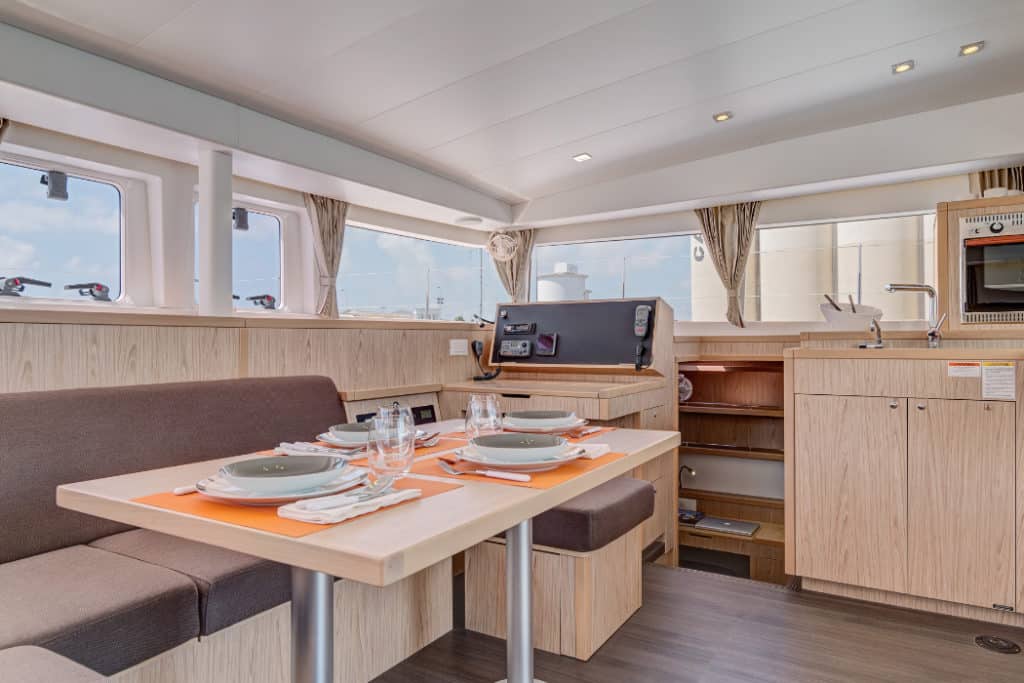
Multihull development in recent years has hit a fork in the road, with one path leading to record-setting speed machines and the other to vessels that carry all the comforts of a very upscale home. The new Lagoon 400 most definitely follows the latter trend, though its designers have proven themselves adept at speed, as well.
The latest creation from the multihull arm of Group Beneteau springs from the design offices of Marc Van Peteghem and Vincent Lauriot Prévost. VPLP has long made spray with some of the world’s fastest multihulls, most recently the record-setting trimarans Banque Populaire and Groupama as well as BMW Oracle Racing’s trimaran in the America’s Cup. The Lagoon 400 is decidedly different, aiming instead to deliver luxurious living in a space comparable to that of a 60-foot monohull.
Still, the Lagoon 400 is very much a sailboat, even in a single-digit breeze. On the day of our Chesapeake Bay test sail, twin hulls and a reasonably large sail plan helped drive the boat at 4.5 to 5.2 knots in 6 to 7 knots of wind when reaching with a screecher set on its short bowsprit. Under power, the 400 loped along at 7 knots, with 40-horsepower Yanmar diesels (30-horsepower engines are standard) running at only 2,200 rpm. As you’d expect, the twin diesels, set nearly 24 feet apart, back the boat up and twirl it around magically.
Under sail, the 400 also tacks well. The small jib is a cinch to handle, and with the roll-up screecher, one gains a simple and minimal sail plan that’s very easy to power up or down. That said, 75 inches of freeboard to the deck plus a high superstructure and low-aspect keels mean this is a boat that shouldn’t be pinched up; it performs best when sailed fully powered and backed off a few degrees from a closehauled heading.
Adding to the power equation is the use of a square-headed mainsail to boost sail area. The Lagoon’s optional sail provides 651 square feet; the standard full-battened mainsail measures in at 603 square feet. Square-headed mainsails usually require the crew to remove the upper batten(s) from the sail, or the sail from the track, when flaking it, but Lagoon has rigged an inventive line system that automatically tensions the upper luff to the spar as it rises. As the sail is lowered, the line loosens so the sail top simply drops into its bag.
The Lagoon 400’s interior is loaded with similar thoughtful details to enhance living in surroundings that are quite bright and open, thanks to the whitewash-finished panels and beech joinery, large ports, and wide soles in the hulls. With engines well aft, the aft double berths are set lower in the hulls, and cutouts allow the crew to crawl into bunks from the sides. Multilayer foam mattresses sit on slats to keep the bottoms ventilated. Halogen fixtures throughout provide excellent lighting.

Choosing a three-cabin option (four different layouts are available) provides an enormous bedroom/office/bath with lots of storage, including space for an optional washing machine. Fillers for V-berth(s) forward easily slide away, giving access to large storage lockers underneath.
The ports that wrap around the bridgedeck saloon are vertical rather than sloped-the signature Lagoon look-to better shade the interior and boost headroom over the settee and nav-station areas. The galley features the expected equipment, plus a molded-in dish drainer. On the boat I sailed, the installation of a second fridge or freezer would cut deeply into available storage space for provisions, but on future boats, Lagoon intends to install overhead cabinets.
Cruising World’s Boat of the Year judges found it hard to operate the latch that locks open the sliding door and window separating the saloon from the cockpit. An owner will want to make sure it’s secure to prevent possible injuries under way. The judges were also concerned that children might be able to access the electrical panel in the saloon, though this, too, could be prevented by a lock and vigilance on the part of the skipper.
The basic structure of the Lagoon 400 includes solid laminate under the water and balsa core above, including in the decks. The hulls and decks are infused with polyester, and the builder applies vinylester resin to hulls as an osmotic barrier.
On deck, one large roof with a smooth sweep extends from the cabin front aft over the cockpit, creating, in essence, an exterior saloon with voluminous lounging space that’s well lit at night by halogen lights overhead.
To run the boat, a dedicated steering and control station rests above and to port that can be effectively enclosed with zippered curtains in foul weather. Steps to the station from the cockpit are flanked by all kinds of good grab bars. Though all halyards and sail-control lines lead to the helm station, I was concerned about the lack of a step onto the cabin top, since a crewmember will eventually need to climb there to zip up the mainsail pouch or do other work at the mast.
Lifelines on deck are a generous 35 inches high and are tripled across the stern. This is a positive safety feature, though the stern lines would need to be opened to access the engine compartments, a concern if done in a big seaway. Teak toerails along the sheer provide good emergency footing. Flush-set hatches on the waist decks eliminate toe stubbers and enhance traffic flow.
From stems to sterns, the new Lagoon is about ease of use. Up front, large lockers flank a windlass and channel that directs chain to an anchor set to deploy on the bow. And once the boat’s anchored, a dinghy can slide up from aft, nest between the hulls, and disembark passengers on transoms that are cutaway inboard and provided with a sturdy handhold. When boarding from the dock, passengers can use the step set into each hulls’ exterior.
Lagoon has built 2,000 catamarans in the past 15 years and knows well the profile of its customers: They enjoy comfortable living afloat. The Lagoon 400 should fit right into the fleet.
Steve Callahan, a frequent CW contributor, is a cat sailor from way back.
Specs
LOA 39′ 3″ (11.96 m.)
LWL 37′ 7″ (11.46 m.)
Beam 23′ 9″ (7.24 m.)
Draft 4′ 0″ (1.22 m.)
Sail Area (main, jib) 952 sq. ft. (88.4 sq. m.)
Displacement 22,817 lb. (10,350 kg.)
D/L 192
SA/D 18.9
Water 79 gal. (299 l.)
Fuel 106 gal. (401 l.)
Holding (two heads) 44 gal. (85 l.)
Mast Height 66′ 7″ (20.29 m.)
Engine Two 30-hp. Yanmars
Designers Marc Van Peteghem,
Vincent Lauriot Prévost
(VPLP)
Price $382,775
Lagoon Catamarans
(410) 280-2368
www.cata-lagoon.com








